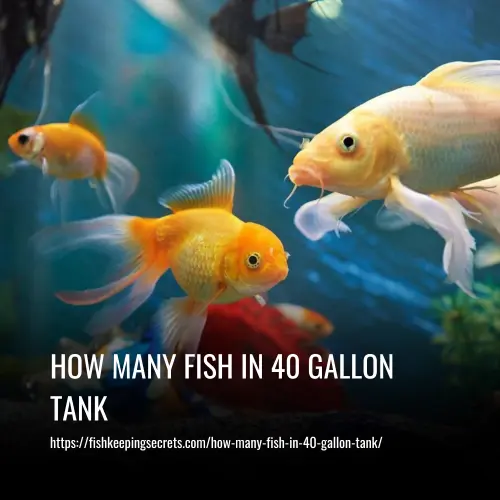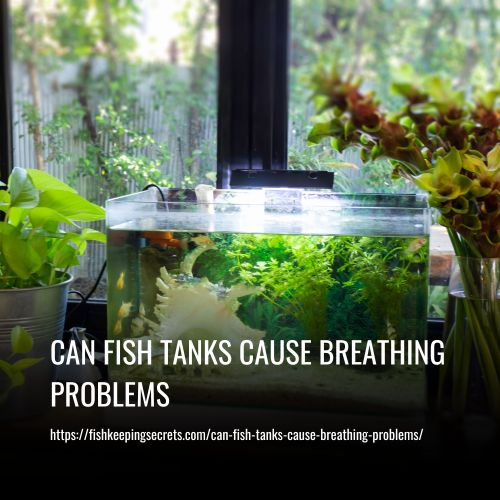A 40 gallon tank can support up to 20-25 small fish or 10-12 medium-sized fish. Having an aquarium at home can be a fantastic way to add a touch of nature to your living space.
If you’re considering setting up a 40-gallon aquarium at your home, you might be wondering how many fish you can keep in it. Keeping too many fish in a tank can lead to poor water quality and can be detrimental to the health of your aquatic pets. On the other hand, keeping an adequate number of fish can contribute to a thriving, healthy environment that your fish will love.

Understanding Tank Capacity
Unlock the secret: how many fish in a 40 gallon tank
When setting up an aquarium, the tank’s size is undoubtedly a crucial factor to consider as it determines how many fish you can keep. However, to provide a suitable habitat for your aquatic pets, it’s not just about the tank’s dimensions but also its capacity.
We’ll discuss the concept of tank capacity and how it relates to the volume of water in the tank. We’ll also explore why it’s essential to contemplate other factors such as filtration, aeration, and fish bioload when assessing tank capacity.
Define What Is Meant By “Tank Capacity” And Discuss How It Relates To The Volume Of Water In The Tank.
In simpler terms, tank capacity means the maximum amount of water your aquarium can hold when filled to the brim. It’s often expressed in gallons and liters and is typically determined by the tank’s dimensions. For instance, a 40-gallon tank’s capacity is 40 gallons of water when filled completely.
It’s essential to note that the volume of water isn’t equal to the volume of the tank. Tank volume only measures its exterior dimensions, whereas the volume of water measures how much space it occupies inside the tank. Therefore, your aquarium’s shape affects its tank capacity as it can influence the water’s surface area, which helps with gas exchange and oxygenation.
Explain Why It Is Important To Consider Factors Such As Filtration, Aeration, And The Bioload Of Fish When Calculating Tank Capacity.
While tank capacity is essential, it should not be the sole determinant of how many fish you can keep in your aquarium. For instance, if you add too many fish to your 40-gallon tank, it could result in inadequate oxygen levels, high ammonia, and more significant nitrate levels, among other issues.
This is why you need to consider other factors when calculating the number of fish to add to your tank. Here are some you should never overlook:
- Filtration: An appropriate filtration system helps remove excess waste, uneaten food, and other debris from your tank, keeping the water clean and healthy for your fish. Ensure you select a filter that can handle at least twice the water volume in your tank.
- Aeration: Adequate aeration is essential as it helps boost the oxygen levels in your aquarium. It’s advisable to use aeration devices such as air pumps or powerheads to provide the necessary oxygenation.
- Fish bioload: Bioload refers to the amount of waste that fish produce, measured in terms of ammonia. Considering the fish bioload is essential, as it provides insight into the number of fish you can keep in your aquarium. Factors that determine bioload include the number and type of fish, feeding regime, and size of the tank.
Understanding tank capacity is vital to keep your fish healthy and happy. However, it’s essential to consider other factors such as filtration, aeration, and the bioload of fish when calculating tank capacity – to do otherwise would be detrimental to the fish and their environment.
Factors That Affect The Number Of Fish You Can Keep In A 40 Gallon Tank
Key Factors That Affect The Number Of Fish You Can Keep In A 40 Gallon Tank
When it comes to keeping fish, it is essential to ensure that they have enough space to swim around and thrive. A 40 gallon tank can be the perfect option for beginner and intermediate aquarium enthusiasts. However, it’s essential to note that several factors impact the number of fish that could safely be kept in such a tank.
Some of these factors include:
- Size of the fish: Larger fish require more space to move around compared to smaller ones. Therefore, a 40 gallon tank can accommodate more small fish compared to larger ones.
- Feeding habits: Some fish are herbivores, while others are carnivores. The type of diet your fish require will affect the number of fish you can keep in your tank. Overfeeding fish can lead to waste buildup, compromising the water quality in your aquarium.
- Rate of waste production: Fish produce waste, which is then broken down into ammonia, nitrites, nitrates. Any increase in these compounds in the aquarium will have adverse effects on the health of your fish.
The Importance Of Considering Species Combinations When Stocking Your Tank
Stocking a fish tank requires careful consideration to avoid overcrowding, which can lead to poor water quality and health problems for the fish. When selecting a fish for your aquarium, it’s necessary to consider their species, behavior, and compatibility.
Here are some key considerations to keep in mind:
- Schooling fish: These fish need to live in groups to thrive, and adding more of them to your tank can be a great way to keep the fish happy and comfortable.
- Aggressive fish: Some fish are naturally aggressive and can become territorial. It’s important to avoid putting these fish in the same tank as other species that are passive.
- Bottom-dwelling fish: This type of fish spends most of their time at the bottom of the tank and can help clean up uneaten food and debris.
Avoiding Overcrowding
Overcrowding a fish tank can lead to several problems, including:
- Poor water quality: Adding too many fish can compromise water quality, leading to an increase of ammonia, nitrite, and nitrate levels.
- Increased fish stress: Fish require space to swim around, and overcrowding can lead to stress, affecting fish’s health over time.
- More maintenance required: An overcrowded tank can require more maintenance, which may involve more frequent water changes, tank cleaning, and filter replacements.
To avoid overcrowding, ensure that you add fish gradually, starting with a small group and slowly adding more as the tank matures. As a general rule of thumb, it’s best to have one inch of adult fish per gallon of water.
While a 40 gallon tank can be a great option for fishkeepers, it’s essential to consider the fish’s size, feeding habits, waste production rate, and species combinations to keep your fish healthy and prevent overcrowding.
Determining The Maximum Fish Count For A 40 Gallon Tank
Choosing the right number of fish for your aquarium is crucial to maintaining a healthy environment. But with so many different methods available, it can be challenging to determine the maximum fish count for your 40 gallon tank. In this section, we will discuss the two most commonly used methods: the surface area method and the inch-per-gallon rule, before outlining how to calculate the bioload of fish and considering it when determining a safe fish count.
Discuss Different Approaches To Determining The Maximum Number Of Fish That Could Be Kept In A 40 Gallon Tank
- Surface area method: This process of measuring the surface area of the tank and relating it to the number of fish that can be comfortably accommodated can produce more accurate results. The recommended surface area of a 40-gallon tank is 400-600 square inches. For smaller fish, you can allow around 1 square inch of surface area per inch of fish. For larger fish, aim for 2-3 square inches per inch of fish.
- Inch-per-gallon rule: This method is based on the size of the tank rather than the surface area. According to this rule, you should allow 1 inch of fish per 1 gallon of water. But, keep in mind that it can be unsuited for larger and more active fish like cichlids.
Evaluate The Pros And Cons Of Each Method And Offer Recommendations On Which Approach To Use In Different Situations
- Surface area method:
- Pros: It takes into account the comfort of the fish, and allows room for growth and movement. It values the well-being of the fish.
- Cons: It might be challenging to calculate and may require extra measurements and considerations. It’s a complex method and might require prior experience and understanding of fishes.
- Recommendation: Use this method if you want to keep fewer but more active and larger fish.
- Inch-per-gallon rule:
- Pros: It is the simplest method and provides a basic guideline for beginners. It’s easier to understand and calculate.
- Cons: It doesn’t consider tank decoration, fish waste production and other factors. It may make your tank crowded and affect the fish’s happiness.
- Recommendation: Beginners who want to keep small and inactive fish can follow this method.
Outline How To Calculate The Bioload Of Fish And Consider It When Determining A Safe Fish Count
- Bioload of fish: It is the amount of waste (in the form of ammonia, nitrate, and nitrite) produced by fish. Interpreting bioload is critical because if not handled properly, it can harm the fish. To calculate the bioload of a particular fish, consider its size, diet, and waste production.
- Other factors to consider when calculating fish count:
- The type of filtration system you use and the fish’s compatibility.
- The type of substrate you use and the size of your tank.
- Proper maintenance and regular water checks are crucial for the health of your fish.
The surface area method is more comprehensive but requires more expertise, while the inch-per-gallon rule is more straightforward and suitable for beginners. Regardless of which method you choose, don’t forget to consider the bioload and other factors when determining a safe fish count in your 40 gallon tank.
Practical Tips For Keeping Fish In A 40 Gallon Tank
Maintaining a fish tank requires knowledge of how to manage water quality and ensure the well-being of the fish within. Here are some practical tips for keeping fish in a 40-gallon tank:
Discuss Best Practices For Maintaining A Healthy Environment In A 40-Gallon Tank
Creating a healthy environment for fish is essential to prevent illnesses and harmful bacterial growth. Here are some best practices for keeping a healthy environment in a 40-gallon tank:
- Regular water changes: Make sure to change at least 25% of the water every two weeks.
- Proper filtration: Choose a filtration system that is suitable for your fish tank’s size and the quantity and type of fish.
- Monitoring water quality: Use a test kit to regularly evaluate ph, ammonia, nitrate, and nitrite levels in the water to ensure that they are within safe limits.
Offer Tips On How To Introduce New Fish To The Tank, Acclimate Them Properly, And Avoid Overfeeding
Adding new fish to a 40-gallon fish tank needs to be done slowly to prevent stress and disease. Here are some tips for introducing new fish to the tank and acclimatizing them properly:
- Quarantine new fish for at least two weeks before adding them to the tank to prevent the spread of disease.
- Slowly acclimate new fish to the water temperature and environment by floating them in a bag or container for 30 minutes to an hour before releasing them in the tank.
- Only feed fish 2-3 times a day with an amount of food that they can consume within three minutes to prevent overfeeding, which can harm the water quality and fish health.
Provide Recommendations For Different Types Of Fish That Are Suitable For A 40-Gallon Tank And The Appropriate Number To Keep
It is essential to ensure that you choose the right type and number of fish for your 40-gallon tank to maintain a healthy environment. Here are some fish species that are suitable for a 40-gallon tank and the recommended number to keep along with them:
- Dwarf gourami: One male and two females
- Guppies: 10-15
- Neon tetras: 10-15
- Platies: 5-6
- Cherry barbs: 5-6
Taking care of a 40-gallon fish tank requires time and attention to ensure the well-being of your fish. By following these practical tips and choosing the right type and number of fish, you can create a healthy and thriving environment for your aquatic friends.
FAQs
The recommended number of fish for a 40-gallon tank is 8-12 small fish or 4-6 medium-sized fish. Ensure not to overstock your aquarium to prevent overcrowding, poor water quality, and stress on the fish.
Yes, you can. However, it would be best to ensure that the fish have similar water temperature, diet, and water hardness requirements. Research the behavior of each fish, compatibility, and purchase appropriate ones to avoid aggression or fights.
Small fish species like tetras, mollies, platies, and guppies are ideal for a 40-gallon tank. Other options include corydoras catfish, dwarf gouramis, and siamese algae eaters. Choose fish that are small, peaceful, and enjoy being in groups.
Clean your 40-gallon tank once a week. Ensure to change 15-20% of the water and gravel vacuum the substrate. You should clean the filters also monthly to prevent the accumulation of algae or harmful bacteria resulting in poor water quality.
Yes, you can keep a single betta fish in a 40-gallon tank. Bettas enjoy having plants in their environment and require ample space to swim. Ensure the water temperature is between 76-82 degrees and check the water quality frequently. Bettas are prone to stress and diseases; therefore, maintain optimum conditions.
Maintain the water quality in your 40-gallon tank by cycling it before adding fish, changing 15-20% of water weekly, cleaning the filter monthly, monitoring ph levels, and performing regular water tests. Ensure the water is suitable for the type of fish you have and avoid overfeeding them to prevent food residue, which affects water quality.
Conclusion
After discussing the various factors that should be taken into consideration when determining how many fish can comfortably exist in a 40-gallon tank, it’s clear that this is not a one-size-fits-all situation. It’s important to consider the species of fish, their size, and their individual needs and behaviors when planning your aquarium.
Overcrowding can lead to stressful and unhealthy living conditions for your fish, so it’s important to err on the side of caution and avoid packing too many fish into your tank. Remember to give your fish ample space, and to regularly test and monitor the water conditions in your aquarium to ensure that your aquatic pets are happy and healthy.
By finding a balance between the number of fish in your tank and their individual needs, you can create a beautiful and thriving aquatic environment that both you and your fish can enjoy for years to come.



